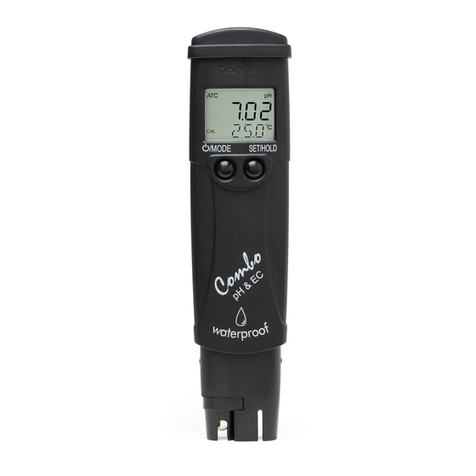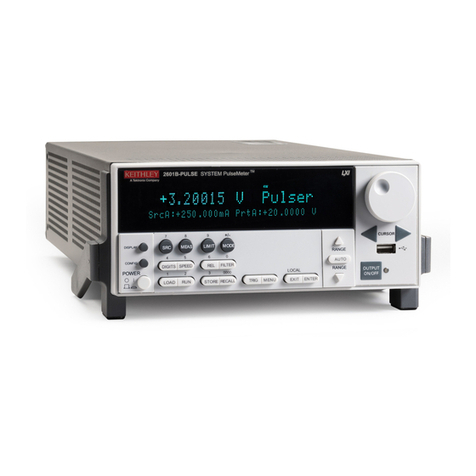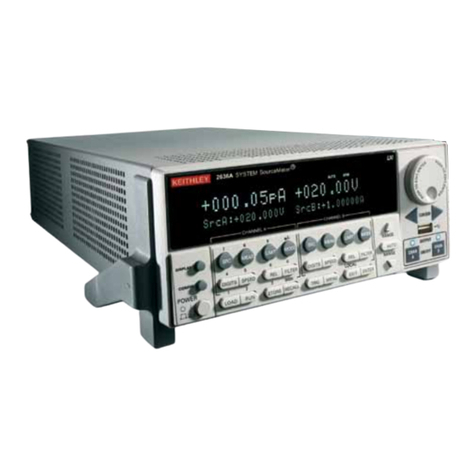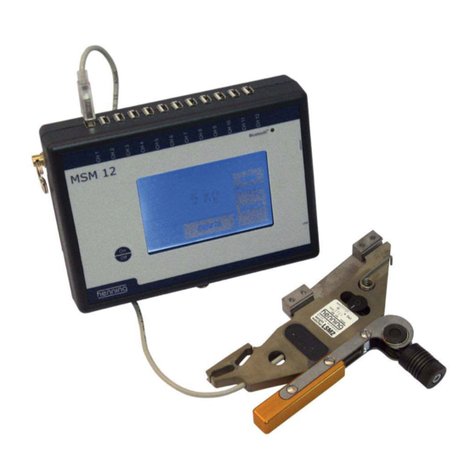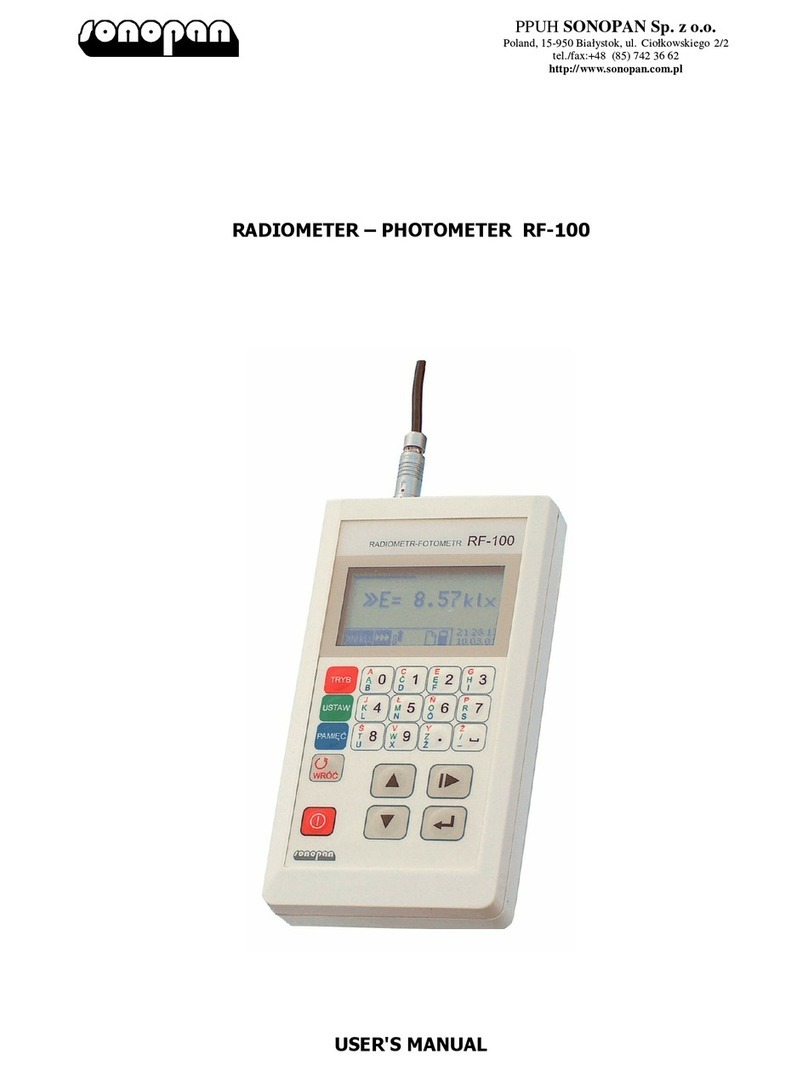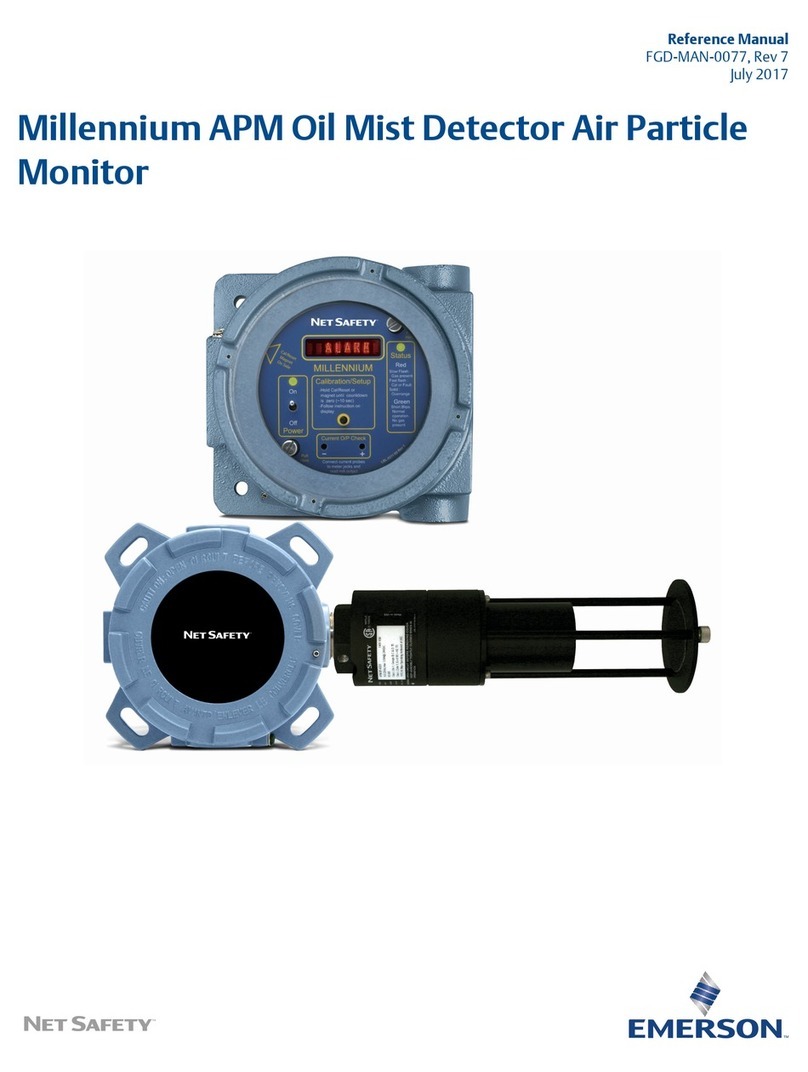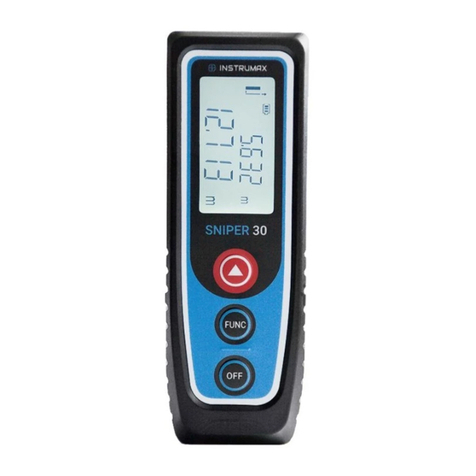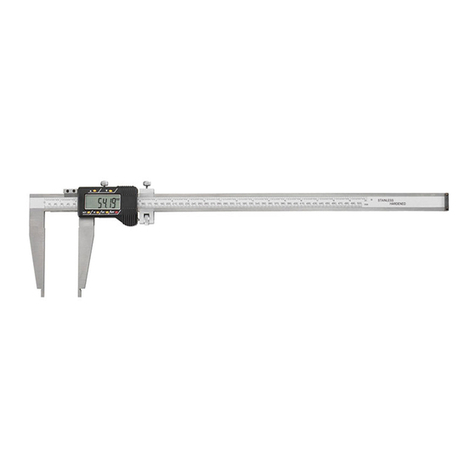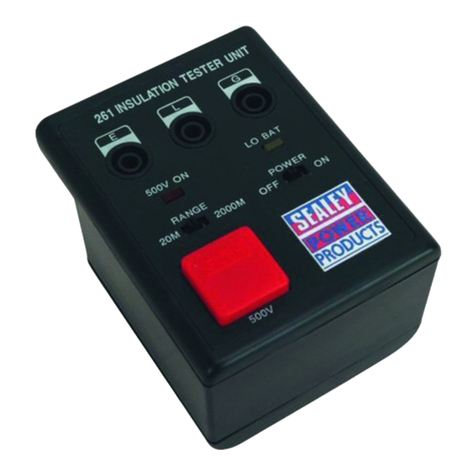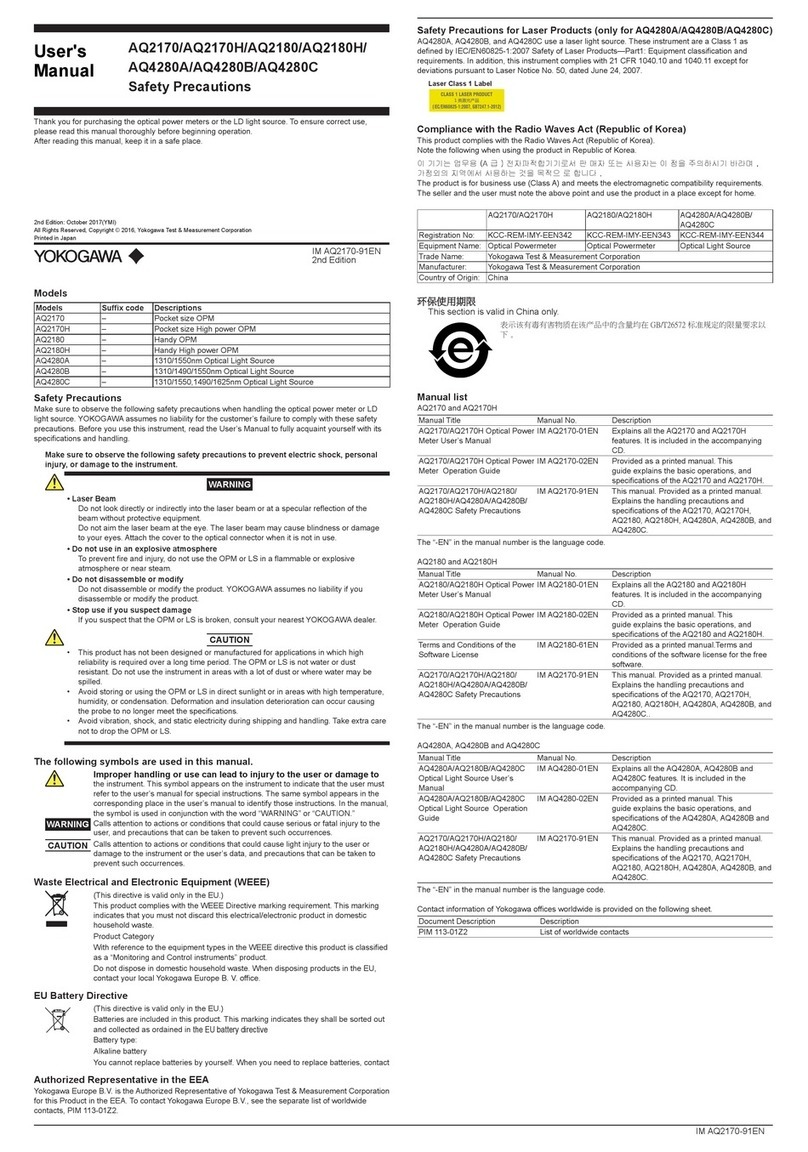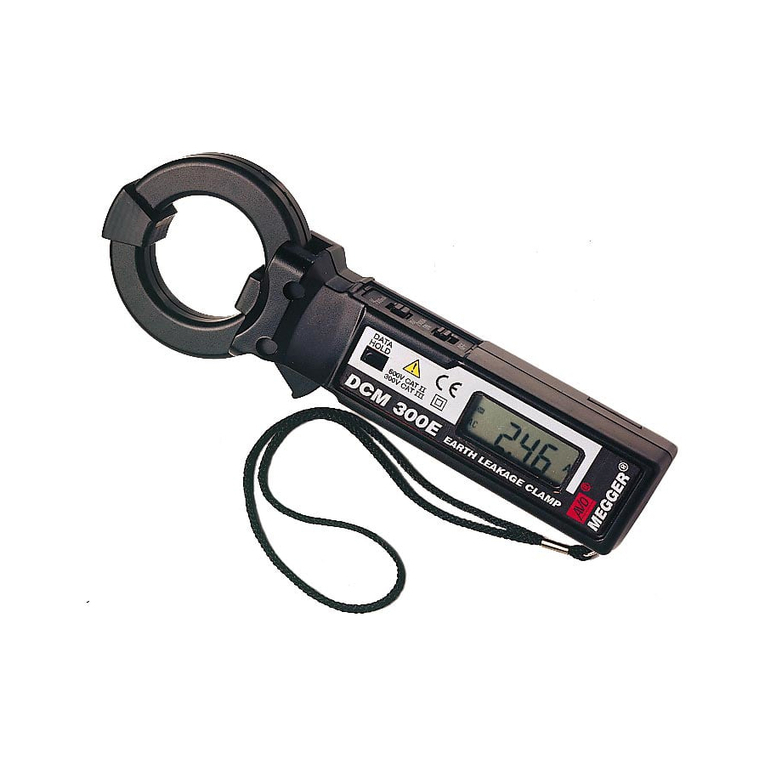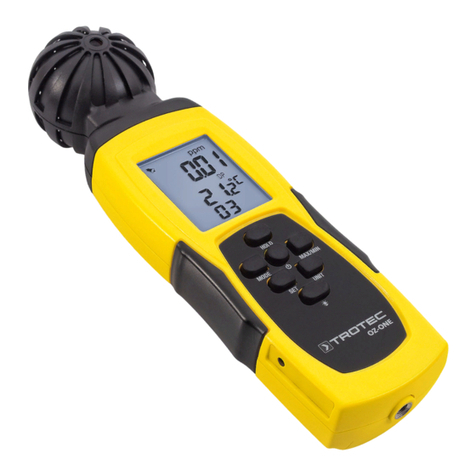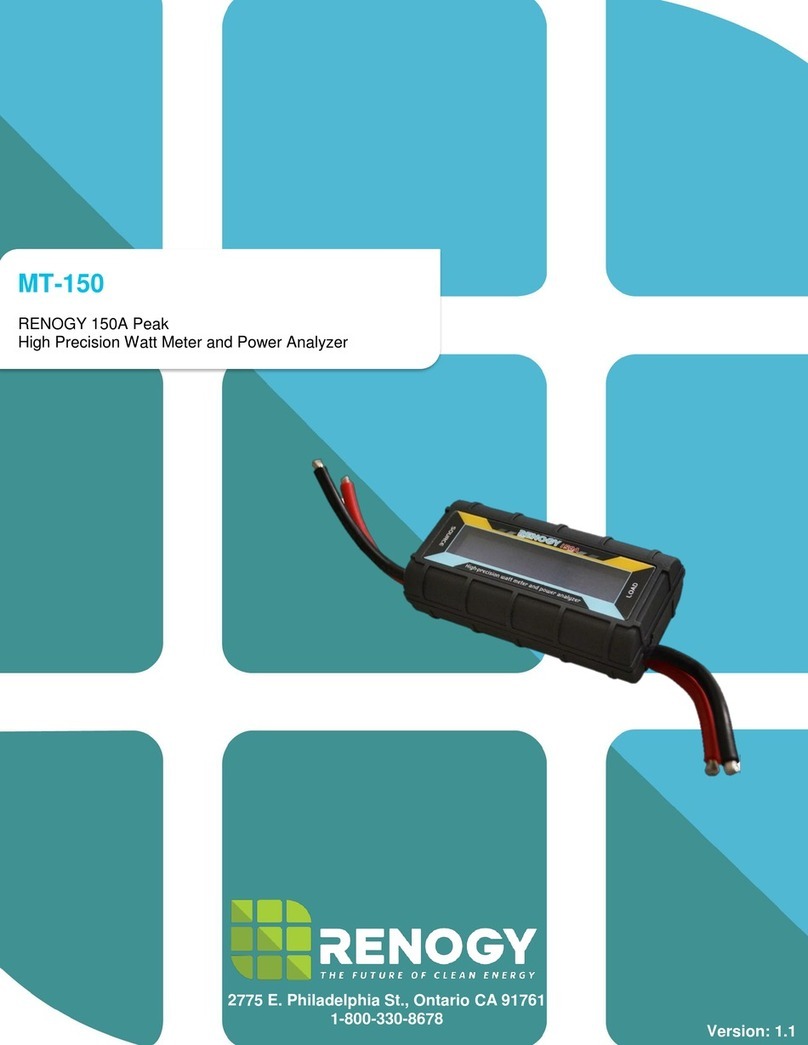Hanna HI 9142 User manual

1
Instruction Manual
HI 9142
Portable Waterproof
Dissolved Oxygen Meter
www. .com information@itm.com1.800.561.8187

23
PRELIMINARY EXAMINATION
Remove the instrument from the packing material and examine it
tomakesurethatnodamagehasoccurredduringshipping.Ifthere
is any damage, notify your Dealer.
The meter is supplied complete with:
•HI 76407/4 DO probe with 4 m cable
••
•
•
•2 spare membranes with O-rings
•HI 7041S electrolyte solution (30 mL)
•Calibration screwdriver
••
••
•Batteries (3 x 1.5V AAA)
••
••
•Instruction manual
••
••
•Rugged carrying case
Note: Save all packing material until you are sure that the
instrument functions correctly. All defective items must
be returned to us in the original packaging with the
supplied accessories.
GENERAL DESCRIPTION
HI 9142 is a rugged, waterproof meter that solves the common
problems of field use, such as cold, rain, snow and dust, that can
damage a meter, rapidly deteriorating its performance and life.
It is very simple to use: calibration is performed with HI 7040
zero
oxygen solution, while 100% calibration is done in air.
The polarographic probe (HI 76407/4) is provided with a
membrane covering the sensors and a built-in thermistor for
temperaturemeasurementand compensation. The thin permeable
membrane isolates the sensor elements from the testing solution,
but allows oxygen to enter. When a voltage is applied across the
sensor, oxygen that has passed through the membrane reacts
causing current to flow, allowing the determination of oxygen.
The probe included with the meter is supplied with a 4 m (13')
cable that allows measurements to be taken even in even hard to
reach places. For applications that require longer probe cables, the
HI 76407/10 and HI 76407/20 probes with a 10 m (33') or 20 m
(67') cable are available.
Dear Customer,
Thank you for choosing a Hanna Instruments Product.
Please read this instruction manual carefully before using the
instrument.
This manual will provide you with all the necessary information
for correct use of the instrument, as well as a precise idea of its
versatility.
TABLE OF CONTENTS
PRELIMINARY EXAMINATION............................................... 3
GENERAL DESCRIPTION ...................................................... 3
PROBE FUNCTIONAL DESCRIPTION ...................................... 4
METER FUNCTIONAL DESCRIPTION ..................................... 5
SPECIFICATIONS ................................................................. 6
PROBE INITIAL PREPARATION ............................................. 7
CALIBRATION PROCEDURE .................................................. 9
TAKING MEASUREMENTS ................................................. 11
ALTITUDE AND SALINITY COMPENSATION .......................... 12
PROBE AND MEMBRANE MAINTENANCE ............................ 14
BATTERY REPLACEMENT ................................................... 16
ACCESSORIES ................................................................... 17
WARRANTY...................................................................... 18
www. .com information@itm.com1.800.561.8187

23
PRELIMINARY EXAMINATION
Remove the instrument from the packing material and examine it
tomakesurethatnodamagehasoccurredduringshipping.Ifthere
is any damage, notify your Dealer.
The meter is supplied complete with:
•HI 76407/4 DO probe with 4 m cable
••
•
•
•2 spare membranes with O-rings
•HI 7041S electrolyte solution (30 mL)
•Calibration screwdriver
••
••
•Batteries (3 x 1.5V AAA)
••
••
•Instruction manual
••
••
•Rugged carrying case
Note: Save all packing material until you are sure that the
instrument functions correctly. All defective items must
be returned to us in the original packaging with the
supplied accessories.
GENERAL DESCRIPTION
HI 9142 is a rugged, waterproof meter that solves the common
problems of field use, such as cold, rain, snow and dust, that can
damage a meter, rapidly deteriorating its performance and life.
It is very simple to use: calibration is performed with HI 7040
zero
oxygen solution, while 100% calibration is done in air.
The polarographic probe (HI 76407/4) is provided with a
membrane covering the sensors and a built-in thermistor for
temperaturemeasurementand compensation. The thin permeable
membrane isolates the sensor elements from the testing solution,
but allows oxygen to enter. When a voltage is applied across the
sensor, oxygen that has passed through the membrane reacts
causing current to flow, allowing the determination of oxygen.
The probe included with the meter is supplied with a 4 m (13')
cable that allows measurements to be taken even in even hard to
reach places. For applications that require longer probe cables, the
HI 76407/10 and HI 76407/20 probes with a 10 m (33') or 20 m
(67') cable are available.
Dear Customer,
Thank you for choosing a Hanna Instruments Product.
Please read this instruction manual carefully before using the
instrument.
This manual will provide you with all the necessary information
for correct use of the instrument, as well as a precise idea of its
versatility.
TABLE OF CONTENTS
PRELIMINARY EXAMINATION............................................... 3
GENERAL DESCRIPTION ...................................................... 3
PROBE FUNCTIONAL DESCRIPTION ...................................... 4
METER FUNCTIONAL DESCRIPTION ..................................... 5
SPECIFICATIONS ................................................................. 6
PROBE INITIAL PREPARATION ............................................. 7
CALIBRATION PROCEDURE .................................................. 9
TAKING MEASUREMENTS ................................................. 11
ALTITUDE AND SALINITY COMPENSATION .......................... 12
PROBE AND MEMBRANE MAINTENANCE ............................ 14
BATTERY REPLACEMENT ................................................... 16
ACCESSORIES ................................................................... 17
WARRANTY...................................................................... 18
www. .com information@itm.com1.800.561.8187

45
METER FUNCTIONAL DESCRIPTION
1. Liquid Crystal Display (LCD)
2. On/Off button
3. °C/°F Celsius or Fahrenheit selection button
4. Zero oxygen calibration button
5. Battery compartment cap
6. Probe connector (DIN7)
7. Calibration button
8. Secondary LCD line
9. Primary LCD line
10. Slope calibration trimmer
1. D.O. probe
2. Protective cap
3. Shielded cable
4. Polypropylene probe body
5. Temperature sensor
6. O-Ring seal
7. Silver chloride (AgCl) anode
8. Platinum cathode (sensor)
9. Oxygen permeable membrane
10. Membrane cap
PROBE FUNCTIONAL DESCRIPTION
9
1
3
4
4
5
6
7
8
9
2
10
8
7
6
www. .com information@itm.com1.800.561.8187

45
METER FUNCTIONAL DESCRIPTION
1. Liquid Crystal Display (LCD)
2. On/Off button
3. °C/°F Celsius or Fahrenheit selection button
4. Zero oxygen calibration button
5. Battery compartment cap
6. Probe connector (DIN7)
7. Calibration button
8. Secondary LCD line
9. Primary LCD line
10. Slope calibration trimmer
1. D.O. probe
2. Protective cap
3. Shielded cable
4. Polypropylene probe body
5. Temperature sensor
6. O-Ring seal
7. Silver chloride (AgCl) anode
8. Platinum cathode (sensor)
9. Oxygen permeable membrane
10. Membrane cap
PROBE FUNCTIONAL DESCRIPTION
9
1
3
4
4
5
6
7
8
9
2
10
8
7
6
www. .com information@itm.com1.800.561.8187

67
PROBE INITIAL PREPARATION
Probe Preparation
All D.O. probes from Hanna Instrument are shipped dry. To
hydrate the probe and prepare it for use, connect it to the
meter and proceed as follows.
1. Remove the red & black plastic cap. This
cap is used for shipping purposes only and
can be thrown away.
2. Wet the sensor by soaking the bottom
(2.5 cm/1") of the probe in HI 7041S
electrolyte solution for 5 minutes.
3. Rinse the membrane (HI 76407A
supplied with the
meter) with some electrolyte
while shaking it gently. Refill
with clean electrolyte.
4. Gently tap the sides of the
membrane with your finger
to ensure that no air bubbles
remain trapped inside.
To avoid damaging the
membrane, do not tap the
membrane directly on the
bottom.
5. Place the rubber O-Ring properly inside the membrane
cap.
6. With the sensor facing down, screw the cap clockwise.
Some electrolyte will overflow.
When not in use and during polarization, protect
the membrane with the supplied cap.
Shipping
cap
black
red
THEN SCREW
BACK ON
THEN TAP
FILL FIRST
SPECIFICATIONS
Range 0.0 to 19.9 mg/L (ppm)
-5.0 to 50.0°C (23.0 to 122.0°F)
Resolution 0.1 mg/L
0.1°C (1°F)
Accuracy ±1.5% FS
±0.2°C (±1°F)
excluding probe error
Calibration Manual in 100% DO
Automatic in 0% DO
Temperature Automatic, 0 to 50°C
Compensation (32 to 122°F)
Probe HI 76407/4, polarographic,
with 4 m (13') cable (included)
Battery Type 3 x 1.5V AAA
Life approx. 1000 hours of use
Auto-off After approx. 8 minutes
Environment 0 to 50°C (32 to 122°F);
RH max 100%
Dimensions 185 x 72 x 36 mm (7.3 x 2.8 x 1.4")
Weight 300 g (10.6 oz.)
www. .com information@itm.com1.800.561.8187

67
PROBE INITIAL PREPARATION
Probe Preparation
All D.O. probes from Hanna Instrument are shipped dry. To
hydrate the probe and prepare it for use, connect it to the
meter and proceed as follows.
1. Remove the red & black plastic cap. This
cap is used for shipping purposes only and
can be thrown away.
2. Wet the sensor by soaking the bottom
(2.5 cm/1") of the probe in HI 7041S
electrolyte solution for 5 minutes.
3. Rinse the membrane (HI 76407A
supplied with the
meter) with some electrolyte
while shaking it gently. Refill
with clean electrolyte.
4. Gently tap the sides of the
membrane with your finger
to ensure that no air bubbles
remain trapped inside.
To avoid damaging the
membrane, do not tap the
membrane directly on the
bottom.
5. Place the rubber O-Ring properly inside the membrane
cap.
6. With the sensor facing down, screw the cap clockwise.
Some electrolyte will overflow.
When not in use and during polarization, protect
the membrane with the supplied cap.
Shipping
cap
black
red
THEN SCREW
BACK ON
THEN TAP
FILL FIRST
SPECIFICATIONS
Range 0.0 to 19.9 mg/L (ppm)
-5.0 to 50.0°C (23.0 to 122.0°F)
Resolution 0.1 mg/L
0.1°C (1°F)
Accuracy ±1.5% FS
±0.2°C (±1°F)
excluding probe error
Calibration Manual in 100% DO
Automatic in 0% DO
Temperature Automatic, 0 to 50°C
Compensation (32 to 122°F)
Probe HI 76407/4, polarographic,
with 4 m (13') cable (included)
Battery Type 3 x 1.5V AAA
Life approx. 1000 hours of use
Auto-off After approx. 8 minutes
Environment 0 to 50°C (32 to 122°F);
RH max 100%
Dimensions 185 x 72 x 36 mm (7.3 x 2.8 x 1.4")
Weight 300 g (10.6 oz.)
www. .com information@itm.com1.800.561.8187

89
PROBE POLARIZATION
The probe is under polarization with a fixed voltage of
approximately 800 mV.
Probe polarization is essential for stable measurements with the
same recurring degree of accuracy.
With the probe properly polarized, oxygen is continually
“consumed“ by passing through the sensitive diaphragm and
dissolving in the electrolyte solution contained in the probe.
If this operation is interrupted, the electrolyte solution continues
to be enriched with oxygen until it reaches an equilibrium with the
surrounding solution.
Whenevermeasurementsaretakenwithanon-polarizedprobe,the
oxygen level revealed are both that of the tested solution as well
of the electrolyte solution. This reading is incorrect.
CALIBRATION PROCEDURE
Connect the probe to the instrument.
Turn the instrument ON by pressing
On/Off.
At start-up the display will show
all the used segments for a
few seconds followed by the
percentage indication of the
remaining battery life.
•After a few seconds “Cnd
Prb” message appears, to
inform the user that the
probe is in auto-conditioning
mode (automatic polarization,
about 1 minute).
Note:Press any key (except On/Off) to skip conditioning
time.
•When the conditioning message disappears, the probe is
polarized and the instrument can be calibrated.
•The meter is now ready to operate.
If the probe is not connected, the display shows “---“ on both
LCD lines.
The auto-off feature turns the instrument off after about 8 min,
if no key is pressed.
The calibration is very simple and fast.
•Make sure the probe is ready for measurements (see initial
preparation at page 7), i.e. the membrane is filled with
electrolyte and the probe is connected to the meter.
•Switch the meter on by pressing the On/Off
key.
•Foranaccuratecalibration,itisrecommended
thatyou wait at least15 minutes toensure
precise conditioning of the probe.
•Remove the protective cap from the D.O.
probe.
www. .com information@itm.com1.800.561.8187

89
PROBE POLARIZATION
The probe is under polarization with a fixed voltage of
approximately 800 mV.
Probe polarization is essential for stable measurements with the
same recurring degree of accuracy.
With the probe properly polarized, oxygen is continually
“consumed“ by passing through the sensitive diaphragm and
dissolving in the electrolyte solution contained in the probe.
If this operation is interrupted, the electrolyte solution continues
to be enriched with oxygen until it reaches an equilibrium with the
surrounding solution.
Whenevermeasurementsaretakenwithanon-polarizedprobe,the
oxygen level revealed are both that of the tested solution as well
of the electrolyte solution. This reading is incorrect.
CALIBRATION PROCEDURE
Connect the probe to the instrument.
Turn the instrument ON by pressing
On/Off.
At start-up the display will show
all the used segments for a
few seconds followed by the
percentage indication of the
remaining battery life.
•After a few seconds “Cnd
Prb” message appears, to
inform the user that the
probe is in auto-conditioning
mode (automatic polarization,
about 1 minute).
Note:Press any key (except On/Off) to skip conditioning
time.
•When the conditioning message disappears, the probe is
polarized and the instrument can be calibrated.
•The meter is now ready to operate.
If the probe is not connected, the display shows “---“ on both
LCD lines.
The auto-off feature turns the instrument off after about 8 min,
if no key is pressed.
The calibration is very simple and fast.
•Make sure the probe is ready for measurements (see initial
preparation at page 7), i.e. the membrane is filled with
electrolyte and the probe is connected to the meter.
•Switch the meter on by pressing the On/Off
key.
•Foranaccuratecalibration,itisrecommended
thatyou wait at least15 minutes toensure
precise conditioning of the probe.
•Remove the protective cap from the D.O.
probe.
www. .com information@itm.com1.800.561.8187

10 11
TAKING MEASUREMENTS
Make sure the meter has been calibrated
and the protective cap has been removed.
Immerse the tip of the probe in the sample
to be tested.
Make sure the temperature sensor is also immersed.
For accurate dissolved oxygen measurements a water movement
of 0.3 m/sec is required at a minimum. This is to ensure that the
oxygen-depleted membrane surface is constantly replenished. A
moving stream will provide adequate circulation. To quickly check
if the water speed is sufficient, wait for the
readingtostabilizeand then move the D.O.
probe. If the reading is still stable, the
measurement conditions are right, while if
the reading increases the water movement
is not adequate.
Duringfield measurements, this conditionmaybemet by manually
agitating the probe. Accurate readings are not possible while the
liquid is at rest.
During laboratory measurements, the use of a magnetic stirrer to
ensure a certain velocity in the fluid is recommended. In this way,
errors due to the diffusion of the oxygen present in the air in the
solution are reduced to a minimum.
At all times, time necessary for thermal equilibrium to occur
betweenthe probe and thesample mustbe allowed(a fewminutes
for temperature difference of several degrees).
SLOPE CALIBRATION
It is suggested to perform the slope calibration in satured air
(100% DO).
•Rinse the probe in a large amount of clean water to remove any
residual zero oxygen solution.
Dry the probe tip and allow a few minutes for the LCD readout
to stabilize.
•Pressthe CALkey and follow theindication
on the display.
•Adjust the slope trimmer on the bottom
ofthemetertoread“100%“ontheLCD.
Note:
•The slope calibration screw is located on
the bottom of the case.
•Press the CAL key and the LCD will
display the value in mg/L of oxygen.
A zero calibration is also possible.
ZERO CALIBRATION
•Dip the probe into HI 7040
zero oxygen
solution and stir gently for 2-3 minutes.
•Press and hold down CAL key then press
ZERO key.
• % tag will blink until the reading stabilize.
•Whenthe reading is stable, themessage “PressCAL, ...., meter
is calibrated“ will be displayed.
•Press CAL to exit zero calibration.
The
zero calibration
of the HI 9142 is very stable, therefore this
procedure needs only to be performed whenever the probe is
replaced.
However, because the slope calibration
is more critical, it is
recommended to perform this procedure every week.
www. .com information@itm.com1.800.561.8187

10 11
TAKING MEASUREMENTS
Make sure the meter has been calibrated
and the protective cap has been removed.
Immerse the tip of the probe in the sample
to be tested.
Make sure the temperature sensor is also immersed.
For accurate dissolved oxygen measurements a water movement
of 0.3 m/sec is required at a minimum. This is to ensure that the
oxygen-depleted membrane surface is constantly replenished. A
moving stream will provide adequate circulation. To quickly check
if the water speed is sufficient, wait for the
readingtostabilizeand then move the D.O.
probe. If the reading is still stable, the
measurement conditions are right, while if
the reading increases the water movement
is not adequate.
Duringfield measurements, this conditionmaybemet by manually
agitating the probe. Accurate readings are not possible while the
liquid is at rest.
During laboratory measurements, the use of a magnetic stirrer to
ensure a certain velocity in the fluid is recommended. In this way,
errors due to the diffusion of the oxygen present in the air in the
solution are reduced to a minimum.
At all times, time necessary for thermal equilibrium to occur
betweenthe probe and thesample mustbe allowed(a fewminutes
for temperature difference of several degrees).
SLOPE CALIBRATION
It is suggested to perform the slope calibration in satured air
(100% DO).
•Rinse the probe in a large amount of clean water to remove any
residual zero oxygen solution.
Dry the probe tip and allow a few minutes for the LCD readout
to stabilize.
•Pressthe CALkey and follow theindication
on the display.
•Adjust the slope trimmer on the bottom
ofthemetertoread“100%“ontheLCD.
Note:
•The slope calibration screw is located on
the bottom of the case.
•Press the CAL key and the LCD will
display the value in mg/L of oxygen.
A zero calibration is also possible.
ZERO CALIBRATION
•Dip the probe into HI 7040
zero oxygen
solution and stir gently for 2-3 minutes.
•Press and hold down CAL key then press
ZERO key.
• % tag will blink until the reading stabilize.
•Whenthe reading is stable, themessage “PressCAL, ...., meter
is calibrated“ will be displayed.
•Press CAL to exit zero calibration.
The
zero calibration
of the HI 9142 is very stable, therefore this
procedure needs only to be performed whenever the probe is
replaced.
However, because the slope calibration
is more critical, it is
recommended to perform this procedure every week.
www. .com information@itm.com1.800.561.8187

12 13
SALINITY COMPENSATION
The table below shows the influence of salt in the measurement
of oxygen.
In HI 9142
all the readouts are referred to 0 g/L of salinity value.
In fact, salinity affects D.O. concentration decreasing its value.
For your reference the table below reports the oxygen solubility
at various temperatures and salinity. From the table you can
calculate the quantity to be subtracted to correct your reading.
ALTITUDE AND SALINITY COMPENSATION
If the sample contains salts or if you are performing the
measurements at a different altitude than sea level, the readout
values must be corrected, taking into account the lower degree of
oxygen solubility.
ALTITUDE COMPENSATION
All the readouts are referred at sea level, thus the displayed
measurements are higher than the actual values. In fact, altitude
affects D.O. concentration decreasing its value. The following
table reports the oxygen solubility at various temperatures and
altitudes, based on sea level barometric pressure of 760 mm Hg.
This gives an idea of the error that can be introduced at different
altitudes and allows you to calculate the quantity to be subtracted
to correct your reading.
C°
leveLaeSevobasreteM,edutitlA
F°
m0 m003 m006 m009 m0021 m0051 m0081
0 6.41 1.41 6.31 2.31 7.21 3.21 8.11 0.23
2 8.31 3.31 9.21 4.21 0.21 6.11 2.11 6.53
4 1.31 7.21 2.21 9.11 4.11 0.11 6.01 2.93
6 4.21 0.21 6.11 2.11 8.01 4.01 1.01 8.24
8 8.11 4.11 0.11 6.01 3.01 9.9 6.9 4.64
01 3.11 9.01 5.01 2.01 8.9 5.9 2.9 0.05
21 8.01 4.01 1.01 7.9 4.9 1.9 8.8 6.35
41 3.01 9.9 6.9 3.9 0.9 7.8 3.8 2.75
61 9.9 7.9 2.9 9.8 6.8 3.8 0.8 8.06
81 5.9 2.9 7.8 6.8 3.8 0.8 7.7 4.46
02 1.9 8.8 5.8 2.8 9.7 7.7 4.7 0.86
22 7.8 4.8 1.8 8.7 7.7 3.7 1.7 6.17
42 4.8 1.8 8.7 5.7 3.7 1.7 8.6 2.57
62 1.8 8.7 5.7 3.7 0.7 8.6 6.6 8.87
82 8.7 5.7 3.7 0.7 8.6 6.6 3.6 4.28
03 5.7 2.7 0.7 8.6 5.6 3.6 1.6 0.68
23 3.7 1.7 8.6 6.6 4.6 1.6 9.5 6.98
43 1.7 9.6 6.6 4.6 2.6 0.6 8.5 2.39
63 8.6 6.6 3.6 1.6 9.5 7.5 5.5 8.69
83 6.6 4.6 2.6 9.5 7.5 6.5 4.5 4.001
04 4.6 2.6 0.6 8.5 6.5 4.5 2.5 4.401
C°
leveLaeSta)L/g(ytinilaS
F°
L/g0 L/g01 L/g02 L/g03 L/g53
01 3.11 6.01 9.9 3.9 0.9 0.05
21 8.01 1.01 5.9 9.8 6.8 6.35
41 3.01 7.9 1.9 6.8 3.8 2.75
61 9.9 3.9 7.8 2.8 0.8 8.06
81 5.9 9.8 4.8 9.7 6.7 4.46
02 1.9 5.8 0.8 6.7 4.7 0.86
22 7.8 2.8 8.7 3.7 1.7 6.17
42 4.8 9.7 5.7 1.7 9.6 2.57
62 1.8 6.7 2.7 8.6 6.6 8.87
82 8.7 4.7 0.7 6.6 4.6 4.28
www. .com information@itm.com1.800.561.8187

12 13
SALINITY COMPENSATION
The table below shows the influence of salt in the measurement
of oxygen.
In HI 9142
all the readouts are referred to 0 g/L of salinity value.
In fact, salinity affects D.O. concentration decreasing its value.
For your reference the table below reports the oxygen solubility
at various temperatures and salinity. From the table you can
calculate the quantity to be subtracted to correct your reading.
ALTITUDE AND SALINITY COMPENSATION
If the sample contains salts or if you are performing the
measurements at a different altitude than sea level, the readout
values must be corrected, taking into account the lower degree of
oxygen solubility.
ALTITUDE COMPENSATION
All the readouts are referred at sea level, thus the displayed
measurements are higher than the actual values. In fact, altitude
affects D.O. concentration decreasing its value. The following
table reports the oxygen solubility at various temperatures and
altitudes, based on sea level barometric pressure of 760 mm Hg.
This gives an idea of the error that can be introduced at different
altitudes and allows you to calculate the quantity to be subtracted
to correct your reading.
C°
leveLaeSevobasreteM,edutitlA
F°
m0 m003 m006 m009 m0021 m0051 m0081
0 6.41 1.41 6.31 2.31 7.21 3.21 8.11 0.23
2 8.31 3.31 9.21 4.21 0.21 6.11 2.11 6.53
4 1.31 7.21 2.21 9.11 4.11 0.11 6.01 2.93
6 4.21 0.21 6.11 2.11 8.01 4.01 1.01 8.24
8 8.11 4.11 0.11 6.01 3.01 9.9 6.9 4.64
01 3.11 9.01 5.01 2.01 8.9 5.9 2.9 0.05
21 8.01 4.01 1.01 7.9 4.9 1.9 8.8 6.35
41 3.01 9.9 6.9 3.9 0.9 7.8 3.8 2.75
61 9.9 7.9 2.9 9.8 6.8 3.8 0.8 8.06
81 5.9 2.9 7.8 6.8 3.8 0.8 7.7 4.46
02 1.9 8.8 5.8 2.8 9.7 7.7 4.7 0.86
22 7.8 4.8 1.8 8.7 7.7 3.7 1.7 6.17
42 4.8 1.8 8.7 5.7 3.7 1.7 8.6 2.57
62 1.8 8.7 5.7 3.7 0.7 8.6 6.6 8.87
82 8.7 5.7 3.7 0.7 8.6 6.6 3.6 4.28
03 5.7 2.7 0.7 8.6 5.6 3.6 1.6 0.68
23 3.7 1.7 8.6 6.6 4.6 1.6 9.5 6.98
43 1.7 9.6 6.6 4.6 2.6 0.6 8.5 2.39
63 8.6 6.6 3.6 1.6 9.5 7.5 5.5 8.69
83 6.6 4.6 2.6 9.5 7.5 6.5 4.5 4.001
04 4.6 2.6 0.6 8.5 6.5 4.5 2.5 4.401
C°
leveLaeSta)L/g(ytinilaS
F°
L/g0 L/g01 L/g02 L/g03 L/g53
01 3.11 6.01 9.9 3.9 0.9 0.05
21 8.01 1.01 5.9 9.8 6.8 6.35
41 3.01 7.9 1.9 6.8 3.8 2.75
61 9.9 3.9 7.8 2.8 0.8 8.06
81 5.9 9.8 4.8 9.7 6.7 4.46
02 1.9 5.8 0.8 6.7 4.7 0.86
22 7.8 2.8 8.7 3.7 1.7 6.17
42 4.8 9.7 5.7 1.7 9.6 2.57
62 1.8 6.7 2.7 8.6 6.6 8.87
82 8.7 4.7 0.7 6.6 4.6 4.28
www. .com information@itm.com1.800.561.8187

14 15
The Platinum cathode (#8 in the Functional Description at page 4)
should always be bright and untarnished. If it is tarnished or
stained, which could be due to contact with certain gases or
extended use with a loose or damaged membrane, the cathode
should be cleaned. Use a lint-free cardboard or cloth and rub the
cathode very gently side to side 4-5 times. This will be enough
to polish and remove any stains without damaging the platinum
tip. Afterwards, rinse the probe with deionized or distilled water
andinstallanewmembranecapusingfreshelectrolyte.Recalibrate
the instrument.
Important: In order to have accurate and stable measurements,
it is important that the surface of the membrane is in perfect
condition. This semi-permeable membrane isolates the sensor
elements from the environment but allows oxygen to enter. If any
dirt is observed on the membrane, rinse carefully with distilled or
deionized water. If any imperfection still exists, or any damage is
evident (such as wrinkles or tears), the membrane should be
replaced. Make sure that the O-Ring is properly seated in the
membrane cap.
PROBE AND MEMBRANE MAINTENANCE
The oxygen probe body is made of reinforced plastic for maximum
durability.
A thermistor temperature sensor provides temperature measurement
and compensation. When not in use, it is always recommended to
protect the probe against damage and dirt using the supplied cap.
To replace the membrane or refill with electrolyte, proceed as
follows:
•Removethe protective cap bygently
twisting and pulling it off (see fig. 1).
•Unscrew the membrane by turning
it counterclockwise (see fig. 2).
•Wet the sensor by soaking the
bottom (2.5 cm) of the probe in
HI 7041S electrolyte solution for
5 minutes.
•Rinse the new membrane (HI 76407A supplied with the
meter) with some electrolyte while shaking it gently. Refill
with clean electrolyte.
•Gentlytapthesides of the membrane
withyourfinger to ensure that no air
bubbles remain trapped inside. Do
no directly tap the bottom as this
will damage the membrane.
•Make sure that the rubber O-ring is
seatedproperly insidethemembrane
cap.
•With the sensor facing down, screw
the membrane cap clockwise. Some
electrolyte will overflow.
TWIST
AND
PULL
fig. 1
UNSCREW
fig. 2
www. .com information@itm.com1.800.561.8187

14 15
The Platinum cathode (#8 in the Functional Description at page 4)
should always be bright and untarnished. If it is tarnished or
stained, which could be due to contact with certain gases or
extended use with a loose or damaged membrane, the cathode
should be cleaned. Use a lint-free cardboard or cloth and rub the
cathode very gently side to side 4-5 times. This will be enough
to polish and remove any stains without damaging the platinum
tip. Afterwards, rinse the probe with deionized or distilled water
andinstallanewmembranecapusingfreshelectrolyte.Recalibrate
the instrument.
Important: In order to have accurate and stable measurements,
it is important that the surface of the membrane is in perfect
condition. This semi-permeable membrane isolates the sensor
elements from the environment but allows oxygen to enter. If any
dirt is observed on the membrane, rinse carefully with distilled or
deionized water. If any imperfection still exists, or any damage is
evident (such as wrinkles or tears), the membrane should be
replaced. Make sure that the O-Ring is properly seated in the
membrane cap.
PROBE AND MEMBRANE MAINTENANCE
The oxygen probe body is made of reinforced plastic for maximum
durability.
A thermistor temperature sensor provides temperature measurement
and compensation. When not in use, it is always recommended to
protect the probe against damage and dirt using the supplied cap.
To replace the membrane or refill with electrolyte, proceed as
follows:
•Removethe protective cap bygently
twisting and pulling it off (see fig. 1).
•Unscrew the membrane by turning
it counterclockwise (see fig. 2).
•Wet the sensor by soaking the
bottom (2.5 cm) of the probe in
HI 7041S electrolyte solution for
5 minutes.
•Rinse the new membrane (HI 76407A supplied with the
meter) with some electrolyte while shaking it gently. Refill
with clean electrolyte.
•Gentlytapthesides of the membrane
withyourfinger to ensure that no air
bubbles remain trapped inside. Do
no directly tap the bottom as this
will damage the membrane.
•Make sure that the rubber O-ring is
seatedproperly insidethemembrane
cap.
•With the sensor facing down, screw
the membrane cap clockwise. Some
electrolyte will overflow.
TWIST
AND
PULL
fig. 1
UNSCREW
fig. 2
www. .com information@itm.com1.800.561.8187

16 17
ACCESSORIES
HI 7040L Zero oxygen solution, 500 mL
HI 7041S Refilling electrolyte solution, 30 mL
HI 7041M Refilling electrolyte solution, 230 mL
HI 7041L Refilling electrolyte solution, 500mL
HI 76407/4 D.O. probe with 4 m (13') cable
HI 76407/10 D.O. probe with 10 m (33') cable
HI 76407/20 D.O. probe with 20 m (66') cable
HI 76407A/P D.O. membrane (5 pcs)
BATTERY REPLACEMENT
When the battery level is low, “BATT“ tag is displayed blinking
on the LCD to advise the user that approx. 1 hour of working time
is left.
It is recommended to change the batteries as soon as the
battery indicator blinks.
To replace the batteries, follow the next steps:
•Turn OFF the instrument.
•Open the battery compartment cap (located on the top of the
instrument).
•Remove old batteries.
•Insert three new 1.5V AAA batteries in the battery compartment,
following the instructions on the rear of the instrument.
•Reattach the battery compartment cap.
The instrument is provided with the BEPS (Battery Error
Prevention System) feature, which automatically turns the
instrument off when the batteries level is too low to ensure
reliable readings.
At start up the display will show “0 % BATT” message for a
few seconds, then the instrument automatically turns off.
www. .com information@itm.com1.800.561.8187

16 17
ACCESSORIES
HI 7040L Zero oxygen solution, 500 mL
HI 7041S Refilling electrolyte solution, 30 mL
HI 7041M Refilling electrolyte solution, 230 mL
HI 7041L Refilling electrolyte solution, 500mL
HI 76407/4 D.O. probe with 4 m (13') cable
HI 76407/10 D.O. probe with 10 m (33') cable
HI 76407/20 D.O. probe with 20 m (66') cable
HI 76407A/P D.O. membrane (5 pcs)
BATTERY REPLACEMENT
When the battery level is low, “BATT“ tag is displayed blinking
on the LCD to advise the user that approx. 1 hour of working time
is left.
It is recommended to change the batteries as soon as the
battery indicator blinks.
To replace the batteries, follow the next steps:
•Turn OFF the instrument.
•Open the battery compartment cap (located on the top of the
instrument).
•Remove old batteries.
•Insert three new 1.5V AAA batteries in the battery compartment,
following the instructions on the rear of the instrument.
•Reattach the battery compartment cap.
The instrument is provided with the BEPS (Battery Error
Prevention System) feature, which automatically turns the
instrument off when the batteries level is too low to ensure
reliable readings.
At start up the display will show “0 % BATT” message for a
few seconds, then the instrument automatically turns off.
www. .com information@itm.com1.800.561.8187

18 19
WARRANTY
HI 9142 is guaranteed for two years against defects in workmanship
andmaterialswhenusedfortheirintendedpurposeandmaintained
according to instructions. Electrodes and probes are guaranteed for
six months. This warranty is limited to repair or replacement free
of charge.
Damage due to accidents, misuse, tampering or lack of prescribed
maintenance is not covered.
If service is required, contact the dealer from whom you purchased
the instrument. If under warranty, report the model number, date
of purchase, serial number and the nature of the problem. If the
repair is not covered by the warranty, you will be notified of the
charges incurred. If the instrument is to be returned to Hanna
Instruments, first obtain a Returned Goods Authorization number
from the Technical Service department and then send it with
shipping costs prepaid. When shipping any instrument, make sure
it is properly packed for complete protection.
Recommendations for Users
Before using this product, make sure that it is entirely suitable for the
environment in which it is used.
Operation of this instrument in residential area could cause unacceptable
interferences to radio and TV equipment, requiring the operator to take
all necessary steps to correct interferences.
Any variation introduced by the user to the supplied equipment may
degrade the instrument's EMC performance.
To avoid electrical shock, do not use this instrument when voltages at the
measurement surface exceed 24 Vac or 60 Vdc.
Toavoiddamagesorburns,donotperformanymeasurementinmicrowave
ovens.
In particular cases the meter could turn off. In these cases it can be turned
on by pressing the ON/OFF key.
Hanna Instruments reserves the right to modify the design, construction
or appearance of its products without advance notice.
Allrightsarereserved.Reproduction inwholeorin partisprohibited
without the written consent of the copyright owner.
www. .com information@itm.com1.800.561.8187

18 19
WARRANTY
HI 9142 is guaranteed for two years against defects in workmanship
andmaterialswhenusedfortheirintendedpurposeandmaintained
according to instructions. Electrodes and probes are guaranteed for
six months. This warranty is limited to repair or replacement free
of charge.
Damage due to accidents, misuse, tampering or lack of prescribed
maintenance is not covered.
If service is required, contact the dealer from whom you purchased
the instrument. If under warranty, report the model number, date
of purchase, serial number and the nature of the problem. If the
repair is not covered by the warranty, you will be notified of the
charges incurred. If the instrument is to be returned to Hanna
Instruments, first obtain a Returned Goods Authorization number
from the Technical Service department and then send it with
shipping costs prepaid. When shipping any instrument, make sure
it is properly packed for complete protection.
Recommendations for Users
Before using this product, make sure that it is entirely suitable for the
environment in which it is used.
Operation of this instrument in residential area could cause unacceptable
interferences to radio and TV equipment, requiring the operator to take
all necessary steps to correct interferences.
Any variation introduced by the user to the supplied equipment may
degrade the instrument's EMC performance.
To avoid electrical shock, do not use this instrument when voltages at the
measurement surface exceed 24 Vac or 60 Vdc.
Toavoiddamagesorburns,donotperformanymeasurementinmicrowave
ovens.
In particular cases the meter could turn off. In these cases it can be turned
on by pressing the ON/OFF key.
Hanna Instruments reserves the right to modify the design, construction
or appearance of its products without advance notice.
Allrightsarereserved.Reproduction inwholeorin partisprohibited
without the written consent of the copyright owner.
www. .com information@itm.com1.800.561.8187

1
Instruction Manual
HI 9142
Portable Waterproof
Dissolved Oxygen Meter
www. .com information@itm.com1.800.561.8187
Table of contents
Other Hanna Measuring Instrument manuals

Hanna
Hanna Foodcare HI99192 User manual

Hanna
Hanna HI 720 User manual

Hanna
Hanna HALO2 User manual

Hanna
Hanna HI 83203 User manual

Hanna
Hanna HI 5221 User manual

Hanna
Hanna HI 96745 User manual

Hanna
Hanna HI 991300 User manual

Hanna
Hanna SALINTEST HI98203 User manual

Hanna
Hanna HI 9811 User manual

Hanna
Hanna HI759 User manual

Hanna
Hanna HI 110 User manual

Hanna
Hanna HI 84502 User manual

Hanna
Hanna HI 5522 User manual
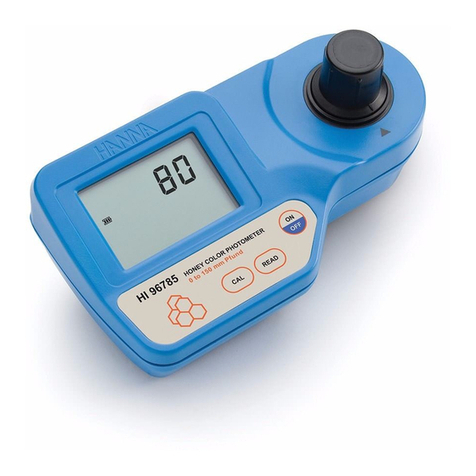
Hanna
Hanna HI 96785C User manual

Hanna
Hanna HI 9835 User manual

Hanna
Hanna HI981032 User manual
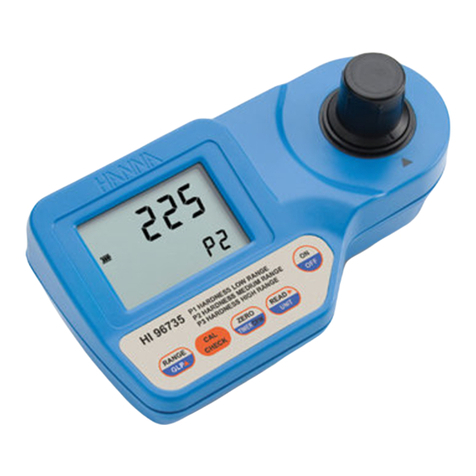
Hanna
Hanna HI 96724 User manual

Hanna
Hanna HI 96736 User manual

Hanna
Hanna edge blu User manual

Hanna
Hanna HI 96734 User manual
